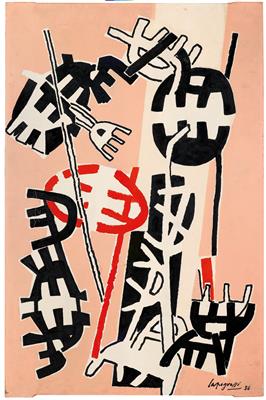Giuseppe Capogrossi *

(Rome 1900–1972)
Superficie 211, 1956, signed Capogrossi 56, on the reverse, on the stretcher, written by the Artist: Superficie 211 - Sacerdoti - Sup.211, one Milan customs stamp on the reverse, oil on canvas, 93 x 61 cm, framed
Photo certificate:
Fondazione Archivio Capogrossi, no. AC/381/OT, Rome , 26 June 2016
Provenance:
Galleria del Naviglio, Milan (stamp on the reverse)
Galleria Falsetti, Prato, inv. no. 7595 (stamp on the reverse) (auction 29 November 1975, lot. no. 2–93 bis)
Private Collection, Italy
Exhibited:
London, Capogrossi, Institute of Contemporary Art, May/June 1957, cat. no. 14
Turin, Esposizione Nazionale di Belle Arti, Palazzo Chiablese, May/June 1958, cat. no. 332
Literature:
Giulio Carlo Argan, Capogrossi, Editalia, Rome, 1967, p. 170, no. 281 (ill. upside- down, with the wrong date :1957)
Around 1950, the painter Mario Ballocco announced the birth of the Origine group. He announced his creation in the pages of AZ Arte Oggi, a magazine he had founded to support non-figurative art. In January 1951 the first and last show of the group was held at Galleria Origine . On that occasion Burri, Capogrossi, Colla and Ballocco himself signed a short text, commonly regarded as the Origine manifesto, in which they declared their determination to free non-figurative art from the fetters of formalism so as endow it with a new spiritual dimension and lead it toward new communicative channels.
In that exhibition, Capogrossi showed paintings made up solely of a recurrent two-dimensional graphic sign soon to be codified as the archetypal Capogrossi sign. He reiterated this primary, self-referential sign for over 20 years in works entitled “Superficie” (“Surface”), distinguished by means of numbering. This was a decision indicative of the value that the artist placed on the dynamic relationship of rhythm and tension created between the sign- developed in countless morphologic variants and organized on the basis of different combinatorial solutions- and the pictorial surface, not a mere support or background but a constituent element of painting, which was understood in turn as a relational field.
The sign becomes a spatial formula, with significant affinities with the tenets of Spazialismo, a movement in which the artist also took part.
The significant and non-signifying form of the same sign, emphasized in its endless reiteration, justifies the decision of critics to locate Capogrossi’s work in the sphere of signic Art Informel, that will be developed in the second half of the 1950s, especially in works of Gastone Novelli and Cy Twombly.
22.11.2016 - 18:00
- Realized price: **
-
EUR 125,000.-
- Estimate:
-
EUR 100,000.- to EUR 150,000.-
Giuseppe Capogrossi *
(Rome 1900–1972)
Superficie 211, 1956, signed Capogrossi 56, on the reverse, on the stretcher, written by the Artist: Superficie 211 - Sacerdoti - Sup.211, one Milan customs stamp on the reverse, oil on canvas, 93 x 61 cm, framed
Photo certificate:
Fondazione Archivio Capogrossi, no. AC/381/OT, Rome , 26 June 2016
Provenance:
Galleria del Naviglio, Milan (stamp on the reverse)
Galleria Falsetti, Prato, inv. no. 7595 (stamp on the reverse) (auction 29 November 1975, lot. no. 2–93 bis)
Private Collection, Italy
Exhibited:
London, Capogrossi, Institute of Contemporary Art, May/June 1957, cat. no. 14
Turin, Esposizione Nazionale di Belle Arti, Palazzo Chiablese, May/June 1958, cat. no. 332
Literature:
Giulio Carlo Argan, Capogrossi, Editalia, Rome, 1967, p. 170, no. 281 (ill. upside- down, with the wrong date :1957)
Around 1950, the painter Mario Ballocco announced the birth of the Origine group. He announced his creation in the pages of AZ Arte Oggi, a magazine he had founded to support non-figurative art. In January 1951 the first and last show of the group was held at Galleria Origine . On that occasion Burri, Capogrossi, Colla and Ballocco himself signed a short text, commonly regarded as the Origine manifesto, in which they declared their determination to free non-figurative art from the fetters of formalism so as endow it with a new spiritual dimension and lead it toward new communicative channels.
In that exhibition, Capogrossi showed paintings made up solely of a recurrent two-dimensional graphic sign soon to be codified as the archetypal Capogrossi sign. He reiterated this primary, self-referential sign for over 20 years in works entitled “Superficie” (“Surface”), distinguished by means of numbering. This was a decision indicative of the value that the artist placed on the dynamic relationship of rhythm and tension created between the sign- developed in countless morphologic variants and organized on the basis of different combinatorial solutions- and the pictorial surface, not a mere support or background but a constituent element of painting, which was understood in turn as a relational field.
The sign becomes a spatial formula, with significant affinities with the tenets of Spazialismo, a movement in which the artist also took part.
The significant and non-signifying form of the same sign, emphasized in its endless reiteration, justifies the decision of critics to locate Capogrossi’s work in the sphere of signic Art Informel, that will be developed in the second half of the 1950s, especially in works of Gastone Novelli and Cy Twombly.
|
Buyers hotline
Mon.-Fri.: 10.00am - 5.00pm
kundendienst@dorotheum.at +43 1 515 60 200 |
| Auction: | Contemporary Art Part I |
| Auction type: | Saleroom auction |
| Date: | 22.11.2016 - 18:00 |
| Location: | Vienna | Palais Dorotheum |
| Exhibition: | 12.11. - 22.11.2016 |
** Purchase price incl. charges and taxes
It is not possible to turn in online buying orders anymore. The auction is in preparation or has been executed already.
